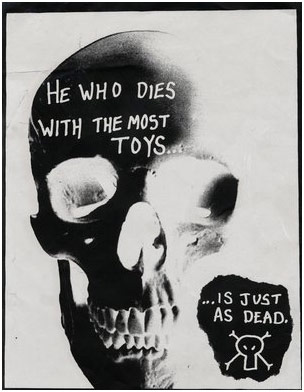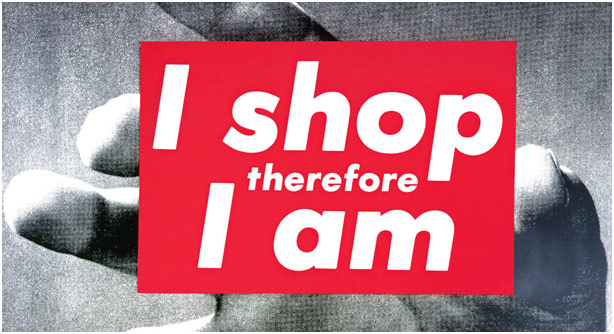
The world we live in promotes consumerism all the time. Sometimes, I feel like I need to take my kids to live in a hut or a cave, far away from civilization if I want to prevent them from falling into the consumerism trap.
Just recently, the big shopping center closest to us was rebuilt. It is now more than double in size. I often have meetings there, in one of the cafes. I always look at all the people rushing past and wonder to myself, “Don’t they have anything better to do than just spend money here?”
Of course, my excuse for being there is that I came there for work!
The scariest thing is going to the supermarket with my kids. We buy most of our groceries from two different supermarkets. To get from one to the other, we need to cross the entire shopping centered, which is shocking.
Every window tells you why you must have that dress and that you are nothing without those shoes and that you are not cool if you don’t buy this and that you are fat if you don’t use that product.
It is completely shocking and terrifying. People we know talk about how they do not have enough money for basic things, and yet their kids seem to have the latest iPhones and the latest brand name jeans that they bought for a bargain at $140 at a half price sale. They are totally over the moon that they can help their kids be considered cool for that price.
My main problem is that this excitement will last for a week at most. After that, the cycle of “buy me!” will start again, because we live in a society that teaches children to be consumers. We live in a society that convinces kids (and their parents) that they are inadequate and that they need to shop in order to survive!
It is a trap because it turns desires and wants into needs. It is a very strong, well-oiled and sophisticated machine. It gives us that idea that “I can only be happy when I have this item”. As parents, we want our children to be happy from every teeny tiny thing they possibly can enjoy. We are helpless before such a well-rehearsed trap.

If we fight against it, you and I have a chance of raising kids who have critical thinking abilities. If consumerism attempts to trap them, they will see right through it and be able to use it to their advantage.
How to save your kids from falling into the consumerism trap
Here are some tips to help prevent kids from falling into the trap of consumerism:
- Encourage them to have hobbies and to engage in them. That way, they will need to resort to computers, TV or shopping with friends when they are bored. When they are young, have a list of “things to do when I am board”. This they will ensure they never use the excuse that they are bored to get you to buy them things.
- Talk about the functionality of everything you purchase. Buying a notebook for school is probably more important than buying a new toy. Having one handbag is useful, but having 600 handbags is probably not going to enrich you. At least not enough to compensate for how much money you spent! We can’t always be function though. We can survive on just bread and butter, but we buy different foods, because we enjoy the variety. We could all survive with only two sets of clothing, but we have more, so we can have a variety to choose from. We can’t it 100% of the time, but never forget the functionality of the things.
- Support and encourage hand-me-downs from an early age. You get some amazing things from friends and siblings that way.
- Do not compare them or yourself to others. This will only teach them that the way to define themselves is through others and what they do and how much they have. Talk about yourself as being able to make your own decisions and feel confident in them.
- Encourage siblings to share toys, clothes and gadgets. Being kind to each other can allow them to have double of what they would have otherwise!
- Teach children to fix things, not just for the money value but the value of being challenged. I am very grateful for my dad who was a curious man and opened every broken thing and fixed it. Some people are afraid to open a broken gadget or toy, in case they ruin it. Remember, it is broken anyway, you have nothing and everything to gain if you can fix it.

- Teach critical thinking about advertising. Teach kids to play different roles. Ask them, “If you are trying to sell a product, what would you do?”. Ask them, “What is the underlying message of this ad?” Teach them to see that at its core, an ad is a manipulation tool. You want them to see the manipulation from miles away.
- If kids want something, ask them to put it on a 30-day waiting list. This is a version of telling them to “sleep on it for 30 days”. Often, they will forget they wanted it. If they still want it 30 days later, you know they were serious about it and it was not just a craze. This list also makes kids pay attention to how many things they want. If, within the 30 days, they want more, ask them to add it to the list. This will help them learn that life is full of choice! You can’t always have everything you want.
- Teach kids to save money. Create a connection between setting saving goals and a good future. Consumerism promotes “I must have it NOW” and life doesn’t work that way. So do your kid a favor. Tell them that the life continues tomorrow.
- Promote recycling and composting. There is an enormous value in caring for the world around us which they cannot learn any other way.
- Teach your kids to enjoy time on their own. That way, they won’t need to use the computer and TV as a way to fight loneliness. Every extra second they spend on the computer or TV, they are bombarded with messages of “buy me now” and they get caught deeper and deeper into the consumer trap.
- Have parties at home rather than at McDonald. Parties at home or in the park allow the focus to be the kid celebrating. At a McDonald party, it is about nothing else except feeding kids, giving them useless collectable toys and entertaining them. I have asked a lot of children and found out that most of the time, they don’t even remember whose party it was!
- If your kid enjoys a buzz cut, use your home trimmer. This is not about the money. It is an opportunity to form a relationship, doing it together with saving money and time.
- Make sure your kids have pocket money from as soon as they can count. Kids need to practice being wise with money and they can only do this when they have their own. With pocket money, if they will fall into the consumerism trap, you can still be there to pick them up!
- Teach kids never to waste food. Teach them to try different food to make them easy eaters and not fussy eaters. Fussiness promotes consumerism. Have you heard of that kid who only eats green grapes, even when they’re not in season?

- Encourage kids to make their own cards for birthdays and holidays. Again, this is not necessarily because of the financial savings but for them to remember that this was the idea behind cards in the first place: to send someone a message of good words, blessings, wishes and comfort. The personal touch is missing when we purchase a card.
- Whenever your kids ask for brand names, talk about the functionality and the cost-benefit. Most importantly, be a role model!
- Leave the magazines in the supermarket checkout aisle. They are nothing but part of the consumerism trap! Get your kids to read books instead.
- If you want to keep costs down, shop at the markets rather than supermarkets. Buy more of what is cheap on that day. If some things are too expensive, you don’t have to buy them. It is good for kids to learn to cook and eat things that are available during each season, rather than focusing only on what they want NOW. People who must buy avocadoes, even if they are ridiculously expensive are great victims of the consumerism trap.
- Teach kids to compare prices. Compare apples to apples. Read the label for ingredients. This will help them ignore the manipulation of the packaging. At our local supermarket, they started writing the price per 100 grams. This makes it easier to compare between brands. We told the kids to ignore the price and look at the price-per-100g.
- Experiment by having a no shopping week. Don’t even get groceries. See what happens. You will find things in your pantry you did not know existed. Teach your kids to think critically about people shopping like crazy just before the holidays. Talk with your kids about the feeling of consumerism that the holiday induces. You want them to understand that nothing will happen to them if they won’t shop for a week.
- Do clean ups of kitchen cupboards/fridge/freezer every six month. This will teach kids to use what you have and not waste things.

- Teach kids to be appreciative of what they have. When they can’t drink water from the fridge and “must have” soft drinks, tell your kids about other children around the world who don’t have water and walk 5 miles carrying heavy buckets for muddy, dirty water. You want them to be grateful for everything they have. It is not the saying of “thank you” that counts but the feeling of “thank you”. Gratitude will teach them to focus on what they have rather than what they don’t have.
- Teach your kids the motto “Be Special, Be Yourself“. Teach your kids that everything we purchase, we do mainly for the feeling it gives us. One of the most important feelings we seek is the freedom of choice. Trying to be cool or follow the fashion is what makes them part of a herd. Talk to them about the herd trap and that being part of a herd takes away their freedom.
It is your responsibility and mine, to make sure our kids don’t fall into the consumerism trap. If you have any more ideas, share them with us in the comment box below.
Happy parenting!
Ronit














